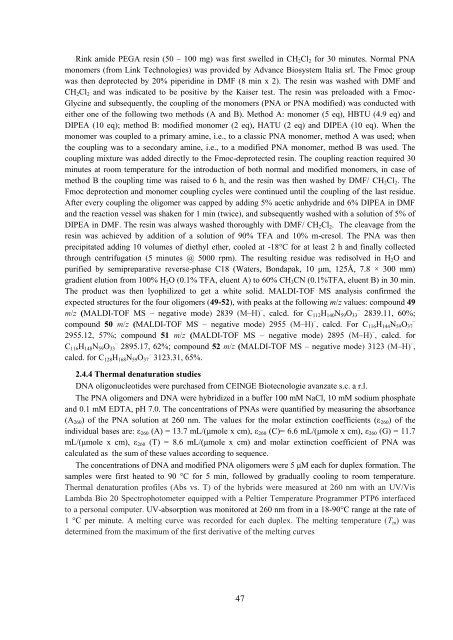Synthesis and characterization of linear and cyclic ... - EleA@UniSA
Synthesis and characterization of linear and cyclic ... - EleA@UniSA
Synthesis and characterization of linear and cyclic ... - EleA@UniSA
You also want an ePaper? Increase the reach of your titles
YUMPU automatically turns print PDFs into web optimized ePapers that Google loves.
Rink amide PEGA resin (50 – 100 mg) was first swelled in CH2Cl2 for 30 minutes. Normal PNA<br />
monomers (from Link Technologies) was provided by Advance Biosystem Italia srl. The Fmoc group<br />
was then deprotected by 20% piperidine in DMF (8 min x 2). The resin was washed with DMF <strong>and</strong><br />
CH2Cl2 <strong>and</strong> was indicated to be positive by the Kaiser test. The resin was preloaded with a Fmoc-<br />
Glycine <strong>and</strong> subsequently, the coupling <strong>of</strong> the monomers (PNA or PNA modified) was conducted with<br />
either one <strong>of</strong> the following two methods (A <strong>and</strong> B). Method A: monomer (5 eq), HBTU (4.9 eq) <strong>and</strong><br />
DIPEA (10 eq); method B: modified monomer (2 eq), HATU (2 eq) <strong>and</strong> DIPEA (10 eq). When the<br />
monomer was coupled to a primary amine, i.e., to a classic PNA monomer, method A was used; when<br />
the coupling was to a secondary amine, i.e., to a modified PNA monomer, method B was used. The<br />
coupling mixture was added directly to the Fmoc-deprotected resin. The coupling reaction required 30<br />
minutes at room temperature for the introduction <strong>of</strong> both normal <strong>and</strong> modified monomers, in case <strong>of</strong><br />
method B the coupling time was raised to 6 h, <strong>and</strong> the resin was then washed by DMF/ CH2Cl2. The<br />
Fmoc deprotection <strong>and</strong> monomer coupling cycles were continued until the coupling <strong>of</strong> the last residue.<br />
After every coupling the oligomer was capped by adding 5% acetic anhydride <strong>and</strong> 6% DIPEA in DMF<br />
<strong>and</strong> the reaction vessel was shaken for 1 min (twice), <strong>and</strong> subsequently washed with a solution <strong>of</strong> 5% <strong>of</strong><br />
DIPEA in DMF. The resin was always washed thoroughly with DMF/ CH2Cl2. The cleavage from the<br />
resin was achieved by addition <strong>of</strong> a solution <strong>of</strong> 90% TFA <strong>and</strong> 10% m-cresol. The PNA was then<br />
precipitated adding 10 volumes <strong>of</strong> diethyl ether, cooled at -18°C for at least 2 h <strong>and</strong> finally collected<br />
through centrifugation (5 minutes @ 5000 rpm). The resulting residue was redisolved in H2O <strong>and</strong><br />
purified by semipreparative reverse-phase C18 (Waters, Bondapak, 10 μm, 125Å, 7.8 × 300 mm)<br />
gradient elution from 100% H2O (0.1% TFA, eluent A) to 60% CH3CN (0.1%TFA, eluent B) in 30 min.<br />
The product was then lyophilized to get a white solid. MALDI-TOF MS analysis confirmed the<br />
expected structures for the four oligomers (49-52), with peaks at the following m/z values: compound 49<br />
m/z (MALDI-TOF MS – negative mode) 2839 (M–H) – , calcd. for C112H140N59O33 – 2839.11, 60%;<br />
compound 50 m/z (MALDI-TOF MS – negative mode) 2955 (M–H) – , calcd. For C116H144N59O37 –<br />
2955.12, 57%; compound 51 m/z (MALDI-TOF MS – negative mode) 2895 (M–H) – , calcd. for<br />
C116H148N59O33 – 2895.17, 62%; compound 52 m/z (MALDI-TOF MS – negative mode) 3123 (M–H) – ,<br />
calcd. for C128H168N59O37 – 3123.31, 65%.<br />
2.4.4 Thermal denaturation studies<br />
DNA oligonucleotides were purchased from CEINGE Biotecnologie avanzate s.c. a r.l.<br />
The PNA oligomers <strong>and</strong> DNA were hybridized in a buffer 100 mM NaCl, 10 mM sodium phosphate<br />
<strong>and</strong> 0.1 mM EDTA, pH 7.0. The concentrations <strong>of</strong> PNAs were quantified by measuring the absorbance<br />
(A260) <strong>of</strong> the PNA solution at 260 nm. The values for the molar extinction coefficients (ε260) <strong>of</strong> the<br />
individual bases are: ε260 (A) = 13.7 mL/(μmole x cm), ε260 (C)= 6.6 mL/(μmole x cm), ε260 (G) = 11.7<br />
mL/(μmole x cm), ε260 (T) = 8.6 mL/(μmole x cm) <strong>and</strong> molar extinction coefficient <strong>of</strong> PNA was<br />
calculated as the sum <strong>of</strong> these values according to sequence.<br />
The concentrations <strong>of</strong> DNA <strong>and</strong> modified PNA oligomers were 5 μM each for duplex formation. The<br />
samples were first heated to 90 °C for 5 min, followed by gradually cooling to room temperature.<br />
Thermal denaturation pr<strong>of</strong>iles (Abs vs. T) <strong>of</strong> the hybrids were measured at 260 nm with an UV/Vis<br />
Lambda Bio 20 Spectrophotometer equipped with a Peltier Temperature Programmer PTP6 interfaced<br />
to a personal computer. UV-absorption was monitored at 260 nm from in a 18-90°C range at the rate <strong>of</strong><br />
1 °C per minute. A melting curve was recorded for each duplex. The melting temperature (Tm) was<br />
determined from the maximum <strong>of</strong> the first derivative <strong>of</strong> the melting curves<br />
47

















